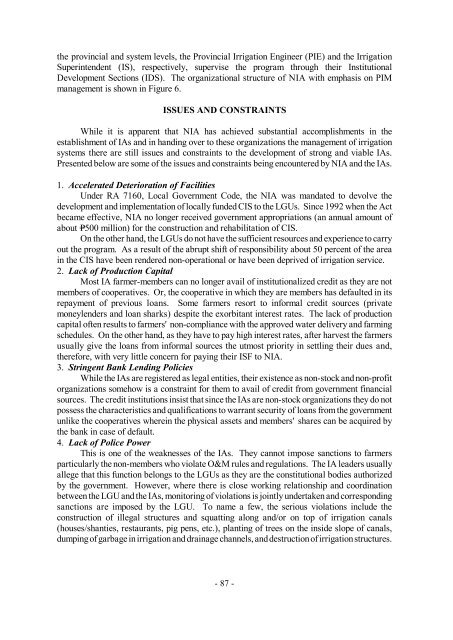Organizational Change for Participatory Irrigation Management
Organizational Change for Participatory Irrigation Management
Organizational Change for Participatory Irrigation Management
You also want an ePaper? Increase the reach of your titles
YUMPU automatically turns print PDFs into web optimized ePapers that Google loves.
the provincial and system levels, the Provincial <strong>Irrigation</strong> Engineer (PIE) and the <strong>Irrigation</strong><br />
Superintendent (IS), respectively, supervise the program through their Institutional<br />
Development Sections (IDS). The organizational structure of NIA with emphasis on PIM<br />
management is shown in Figure 6.<br />
ISSUES AND CONSTRAINTS<br />
While it is apparent that NIA has achieved substantial accomplishments in the<br />
establishment of IAs and in handing over to these organizations the management of irrigation<br />
systems there are still issues and constraints to the development of strong and viable IAs.<br />
Presented below are some of the issues and constraints being encountered by NIA and the IAs.<br />
1. Accelerated Deterioration of Facilities<br />
Under RA 7160, Local Government Code, the NIA was mandated to devolve the<br />
development and implementation of locally funded CIS to the LGUs. Since 1992 when the Act<br />
became effective, NIA no longer received government appropriations (an annual amount of<br />
about P=500 million) <strong>for</strong> the construction and rehabilitation of CIS.<br />
On the other hand, the LGUs do not have the sufficient resources and experience to carry<br />
out the program. As a result of the abrupt shift of responsibility about 50 percent of the area<br />
in the CIS have been rendered non-operational or have been deprived of irrigation service.<br />
2. Lack of Production Capital<br />
Most IA farmer-members can no longer avail of institutionalized credit as they are not<br />
members of cooperatives. Or, the cooperative in which they are members has defaulted in its<br />
repayment of previous loans. Some farmers resort to in<strong>for</strong>mal credit sources (private<br />
moneylenders and loan sharks) despite the exorbitant interest rates. The lack of production<br />
capital often results to farmers' non-compliance with the approved water delivery and farming<br />
schedules. On the other hand, as they have to pay high interest rates, after harvest the farmers<br />
usually give the loans from in<strong>for</strong>mal sources the utmost priority in settling their dues and,<br />
there<strong>for</strong>e, with very little concern <strong>for</strong> paying their ISF to NIA.<br />
3. Stringent Bank Lending Policies<br />
While the IAs are registered as legal entities, their existence as non-stock and non-profit<br />
organizations somehow is a constraint <strong>for</strong> them to avail of credit from government financial<br />
sources. The credit institutions insist that since the IAs are non-stock organizations they do not<br />
possess the characteristics and qualifications to warrant security of loans from the government<br />
unlike the cooperatives wherein the physical assets and members' shares can be acquired by<br />
the bank in case of default.<br />
4. Lack of Police Power<br />
This is one of the weaknesses of the IAs. They cannot impose sanctions to farmers<br />
particularly the non-members who violate O&M rules and regulations. The IA leaders usually<br />
allege that this function belongs to the LGUs as they are the constitutional bodies authorized<br />
by the government. However, where there is close working relationship and coordination<br />
between the LGU and the IAs, monitoring of violations is jointly undertaken and corresponding<br />
sanctions are imposed by the LGU. To name a few, the serious violations include the<br />
construction of illegal structures and squatting along and/or on top of irrigation canals<br />
(houses/shanties, restaurants, pig pens, etc.), planting of trees on the inside slope of canals,<br />
dumping of garbage in irrigation and drainage channels, and destruction of irrigation structures.<br />
- 87 -
















